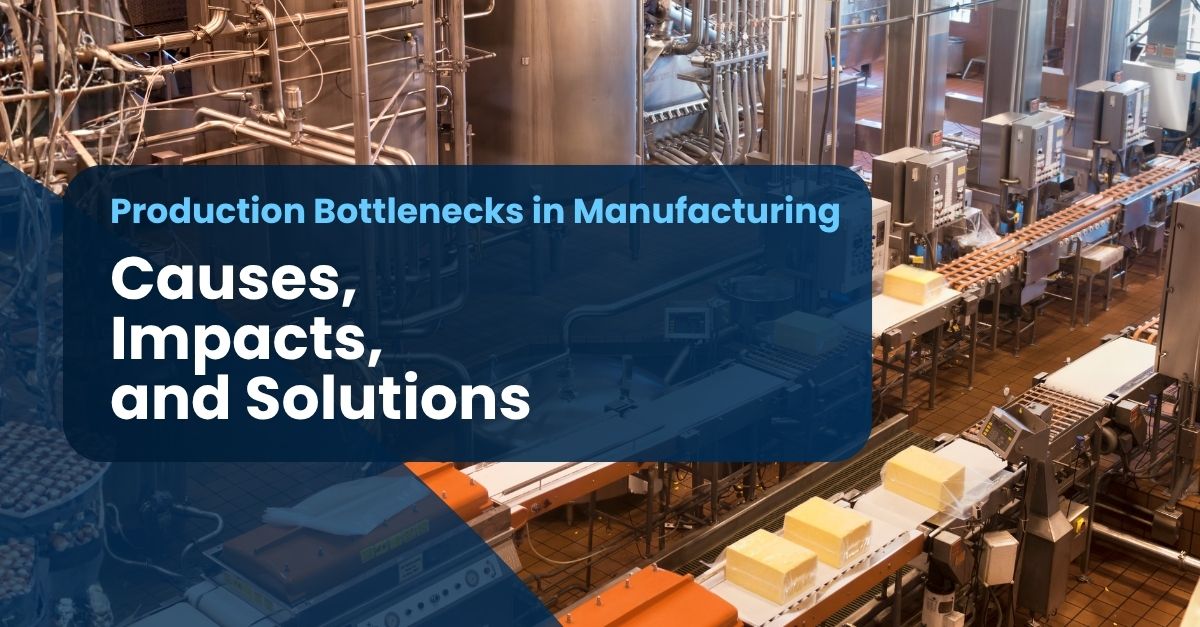
Every manufacturer has felt that gut punch: the assembly line that was cruising along suddenly stalls, leaving workers idle and orders piling up.
These moments aren’t just annoying. They signal production bottlenecks, the hidden drags that can slash efficiency and balloon costs. As U.S. factories navigate reshoring booms, AI upgrades, and supply chain challenges, bottlenecks threaten to cap growth despite optimistic outlooks. This comprehensive guide breaks down what production bottlenecks really are, their top causes, where they hide in your value chain, the eye-watering $50 billion annual hit to U.S. manufacturing, proven fixes, and fresh strategies to stay ahead. If you’re battling line slowdowns or plotting supply chain resilience, read on for tools to spot and smash these roadblocks.
What Is a Production Bottleneck in Manufacturing?
A production bottleneck in manufacturing is the slowest step in your process that caps the whole system’s output, no matter how fast everything else runs. Think of it as the narrowest part of a riverbed: water backs up upstream and trickles downstream, no matter the flow elsewhere.
Experts define a bottleneck as a point of congestion in a production system that stops or severely slows the system, often leading to excess work-in-process inventory before the choke and idle time after. In lean terms, it hits when demand exceeds capacity at one spot, creating imbalances that ripple through your shop floor.
These aren’t always fixed flaws. They can shift in high-variety setups like custom job shops, triggered by product changes or rush jobs. The Theory of Constraints (TOC) calls it your chain’s weakest link: identify it, protect it, then strengthen it to boost overall throughput by 20-50% in many cases. For a quick visual on how this plays out in an assembly line:
Bottleneck
Process Time Analysis
Total Process Time = 3 min + 3 min + 6 min = 12 min/shirt
Here, the sewing machine’s low capacity (10 shirts per hour) bottlenecks the line, even as upstream steps handle 20 each.
Common Causes of Production Bottlenecks in Manufacturing
Production bottlenecks in manufacturing spring from a mix of people problems, tech glitches, and process hiccups. Recent surveys pin 20-30% of throughput losses on these, with causes varying by industry but often overlapping. Here’s a rundown of the most frequent offenders, based on industry data:
- Equipment Breakdowns and Aging Machinery: Sudden failures or underpowered tools grind lines to a halt. Inadequate maintenance planning, like skipped checks due to tight deadlines, tops the list at 25% of incidents. With many U.S. plants running legacy gear, this cause alone spikes unplanned downtime.
- Labor Shortages and Skill Gaps: Missing workers or untrained staff slow key stations. The U.S. faces a projected 2.1 million unfilled manufacturing jobs by 2030, with high-turnover roles like welding amplifying this in automotive and electronics.
- Supply Chain Delays and Material Shortages: Late parts starve the line, especially amid geopolitical tensions and port congestion that stretch lead times. Overestimating demand piles up excess stock, while underestimating triggers shortages in 15-20% of cases. These disruptions create ripple effects, leading to production delays and higher costs.
- Flawed Workflows and Scheduling Errors: Uneven workloads, batch mismatches, or poor layouts waste cycles. In job shops, ad-hoc scheduling causes 25% of delays, often from misaligned takt time (demand pace) versus actual cycle rates.
- Quality Defects Requiring Rework: Faulty outputs loop back, hogging resources. Food and pharma lines lose hours to batch cleanups between runs, inflating defects by 5-10%.
- Forecasting Misses and Siloed Communication: Bad demand predictions lead to overstaffing or rushes, boosting errors 10-15%. Maintenance delays in heavy industry have tripled downtime in recent years.
Spot these early with regular audits to keep your production bottlenecks in manufacturing from snowballing.
Where Do Production Bottlenecks Occur in the Manufacturing Value Chain?
Production bottlenecks in manufacturing can strike any link in the value chain, from raw inputs to final shipping, sending shockwaves everywhere. Using Porter’s model, we map them across primary activities, plus support layers that feed them all:
Inbound Logistics: Sourcing and Supplier Handovers
External snarls like vendor delays or quality rejects create “starved” lines before production kicks off. Import cost pressures bottleneck plants by inflating lead times on components, as seen in electronics waiting on overseas parts and idling millions in daily equipment.
Operations: Assembly, Machining, and Core Fabrication
Most bottlenecks lurk here, in the production heart. Machine limits or labor crunches slow steps, with static ones (like oven capacity) persisting and dynamic ones flipping with product mixes. Furniture makers often cap at 60 units per hour in assembly while upstream cuts 100, per line audits.
Outbound Logistics: Packaging, Warehousing, and Delivery
Post-build chokes include sloppy packing or carrier backups, missing service levels. E-commerce surges spike 15% of delays here, turning finished goods into backlogged orders.
Support Activities: HR, Tech, and Procurement Across the Board
Skills shortages in HR, clunky ERP systems, or vendor dependencies underpin everything. A procurement lag can bottleneck assembly three steps down, as value stream mapping reveals.
Supply chain bottlenecks (external, unpredictable) differ from internal production line ones (controllable), but both need end-to-end visibility to tame.
The True Cost of Production Bottlenecks: $50 Billion Yearly Drain on U.S. Manufacturing
Production bottlenecks in manufacturing exact a brutal toll, mostly via unplanned downtime that idles assets and crews. U.S. factories lose up to $50 billion annually to this, per industry benchmarks, covering lost output, rush shipping, and inventory bloat. Automotive plants alone bleed $260,000 per hour stopped.
Dig deeper:
- Direct Hits: Idle wages and machines run $50,000 to $5 million hourly, scaled by firm size.
- Ripple Effects: Defect rates jump 5-10%, customers bail, and broader economic drags follow from chain clogs.
- Global Scale: Top firms forfeit $1.4 trillion yearly, or 11% of revenue.
Clearing these could unlock 20% more capacity for many operations.
How to Identify and Fix Production Bottlenecks in Manufacturing
Don’t hunt bottlenecks blind. Use these proven tools:
- Value Stream Mapping: Chart flows to flag queues and waits, cutting waste 20-30%.
- Takt Time Checks: Pit demand against cycle speeds; gaps scream constraints.
- Gemba Walks: On-floor eyes uncover overlooked snags.
- AI and IoT Monitoring: Real-time alerts predict issues, lifting uptime 20% via platforms like ThingWorx.
Fix with the “people-process-tech” triad: Crosstrain crews short-term, predictive maintenance long-term to drop downtime 40%. TOC steps guide: Exploit the bottleneck, align the rest, then elevate it. Tactics include redesigning workflows, reallocating resources, and automating tasks.
Real-World Case Studies: Overcoming Production Bottlenecks in Manufacturing
In our work at POWERS, we’ve helped clients across industries smash through bottlenecks with data-backed transformations. Here are four standout examples:
POWERS Unlocks Capacity and Cuts $2.4M in Costs for Global Nutrition Company: Facing unstable operations at 71% OEE, reactive maintenance (70% of work), unclear production goals wasting 30% of supervisor time, and $232K monthly quality claims, this global nutrition leader risked revenue loss amid rising demand. POWERS deployed a comprehensive Management Operating System (MOS) with tools like Daily Weekly Operating Reports (DWOR), tiered meetings, Short Interval Control (SIC), Gemba Walks, structured maintenance planning, and leadership coaching to drive proactive behaviors. In seven months, results included 19.8% throughput growth (to 805K MT), OEE surging to 95%, $2.36M conversion cost reduction (25% improvement), $927K annualized quality savings, 68% fewer customer complaints, and total annualized savings exceeding $5M.
POWERS Reduces Labor Costs by 30% With Smarter Processes: A medical and personal care manufacturer battled unreliable scheduling, inaccurate standards causing over/under-production, weak handoffs idling machines, reactive maintenance (30% mechanic idle time, no KPIs), and low supervisor engagement (just 6% frontline time), with startups at 60% and labor at 10% of budget. Over 24 weeks, POWERS rolled out preventive maintenance with daily/weekly planning and KPIs, validated run rates for accurate standards, leadership workshops for standardized routines, and real-time Vorne monitoring for visibility. Outcomes: 30% labor cost drop (to 7% of budget, eliminating 29 positions), startup performance up 50% to 90%, three months of record financials, and enhanced supply chain predictability through better adherence.
Recipe for Success: A Food Manufacturer Achieves 208% Annualized ROI with POWERS: This food producer grappled with low cook room throughput (25 batches/day), 59% on-time starts, 47% non-mechanical downtime, high turnover, and an underused MOS (75% elements missing), lacking KPIs like Schedule Attainment and Efficiency. POWERS launched a 12-week sprint with operational assessments, leadership development for proactive culture, enhanced MOS for hourly monitoring and attainment tracking, and goals like 40+ daily batches. Key metrics: 208% annualized ROI, 18% filling yield gain (75% to 89%), 28% mix performance boost (53% to 68%), 22% pack performance rise (53% to 65%), and 50% labor efficiency increase (17.2 to 25.8 pieces per labor hour).
From Tradition To Innovation: Restructuring Operations With LCT Captures $3.46 Million In Annualized Savings: Hampered by no hourly throughput tracking, absent short-interval follow-ups, unclear capacity expectations, and missing KPIs/visuals stifling engagement and CI, this food manufacturer suffered persistent variances and waste. POWERS introduced a Line Centric Teams (LCT)-based MOS with dedicated line leads, KPIs for productivity/quality, visual dashboards, tiered meetings, root cause analysis, and a 12-week sprint targeting 5% throughput gains. Achievements: 6% performance uplift, 12% waste reduction, $344K savings in the sprint (annualizing to $3.46M), surpassing the $98K goal and expanding to more lines.
These projects highlight how targeted POWERS interventions deliver rapid, measurable ROI.
Emerging Trends: AI and Resilience Against Production Bottlenecks in Manufacturing
AI reshapes bottleneck battles: Dynamic scheduling yields 15% throughput wins for adopters, while IoT flags failures pre-stall. But workforce hurdles loom, with over half of execs naming skills as top risks. Nearshoring eases global delays but strains domestic logistics; sustainability rules add process layers, risking 10% efficiency slips sans digitization. Pro tip: Bake “resilience costing” into plans, balancing buffers with lean cuts.
Wrapping Up: Conquer Production Bottlenecks in Manufacturing Today
Production bottlenecks in manufacturing are tough, but armed with causes, chain spots, and $50 billion stakes, you’re set to act. In the shift to smart factories, turn these pains into gains: Start a value stream map this week. Your output, and profits, depend on it. Ready to apply these strategies with expert guidance?
About POWERS: Your Partner in Reducing Production Friction Points
POWERS equips manufacturing leaders to thrive in volatile markets by targeting and eliminating production bottlenecks through expert process optimization, cultural alignment, supply chain management, maintenance performance improvement, and frontline leadership development. Our DPS platform delivers real-time performance insights to pinpoint and resolve chokepoints, ensuring sustainable, scalable gains in throughput, productivity, and profitability. With decades of cross-industry expertise, we provide comprehensive assessments and hands-on implementation to build agile, resilient, high-performing operations that eliminate bottlenecks and drive lasting excellence.
Take the Next Step Toward a Leadership Cascade
- Speak to an Expert: Call +1 678-971-4711 to discuss how frontline leadership development and DPS can close your skills gap and streamline tech adoption.
- Email Us: Reach out to info@thepowerscompany.com for personalized insights on reducing friction in your operations.
- Request an Assessment: Visit our online contact form to schedule an assessment with our expert consultants, identifying quick wins to equip your leaders and boost performance.

